Crews of the SMS Goeben and SMS Breslau
When the SMS Goeben and SMS Breslau were transferred to Ottoman service
in 1914, their crews continued to wear the same German naval uniforms as
before (see German Navy
Other Ranks)
and German Navy Officers) but replacing their usual naval caps with an Ottoman red felt fez with a
black tassel. They continued to
wear this combination of German and Ottoman uniforms on board ship
throughout the First World War, though some period photographs show them wearing
still their old German caps. Several different cap tallies have been
seen in modern collections such as "S.K.O.M.O.S. JAVOUS SULTAN SELIM
I." for the renamed SMS Goeben and "S.M.S. MIDILLI" for the renamed
SMS Breslau (see the
Turkish
Militaria website). According to "Dunya
Savasi'nda Turk Askeri Kiyafetleri 1914-1918"
by Tunca Orses and Necmettin Ozcelik,
a cap tally was issued which read "Türkische Marine"
or "Osmanische Türkische Marine", as
the sailors were now officially in the Ottoman navy. So far I have
been unable to verify this from period photographs.Land Based Units
The first land based units from the SMS Goeben and SMS Breslau were machine gun sections who fought at
Gallipoli. At first they wore their blue and white naval uniforms (with
German naval caps) but due to their conspicuousness in action and
confusion about which side they were on, they were soon issued with
standard Ottoman army uniforms in dark khaki with the Kabalak headgear
(see Ottoman Uniforms
Page). Throughout the war officers and sailors from the SMS Goeben and SMS
Breslau served on various middle eastern fronts often in Ottoman army
uniform.
German Naval Staff
German naval officers also served as
staff and advisors to the Ottoman empire. From photographs it seems they
usually wore standard German naval uniforms, although one photograph of an
officer of the naval mission in Baghdad shows him wearing a khaki
tropical uniform similar to that of the
Seebatallione.
The Illustrations
Figure 1 is based on a
photograph of a Naval Officer, Rear Admiral Souchon of the SMS Goeben. He
wears a standard German naval officers uniform- a double breasted dark blue jacket
with five brass buttons on each side and matching trousers but with an
Ottoman red fez as described above. Typically for naval officers he
wears a neat shirt and thin black tie under his jacket. His rank is
shown in the form of one thin and one triple thick bar of gold lace
under a German Imperial crown, showing him to be a Rear Admiral ("Kontra-Admiral").
On his left breast are three medals. One is unidentified, the other two
are the Ottoman Gold Liakat and an Iron Cross
First Class (see right and Medals Page
for the full display of Admiral Souchon's medals).
| |
Wilhelm Anton Souchon
(1864-1946) was given command of the Imperial German Mediterranean Squadron ("Mittelmeerdivision")
in 1912. The squadron consisted only of the Battlecruiser SMS Goeben and the Light
Cruiser SMS Breslau, yet their impact on the course of the First World War went
well beyond their firepower. Winston Churchill said that by their actions
bringing the Ottoman Empire into the war, they brought "more slaughter, more
misery and more ruin than has ever before been borne within the compass of a
ship." When war broke out in Europe, Rear Admiral Souchon left the
Austro-Hungarian port of Pola (in modern Croatia) and led his ships to bombard
French ports in Algeria. He then dodged British attempts to corner him and
headed for Istanbul where his ships were transferred to the Ottoman navy. It was
while in Ottoman service that they bombarded the Russian Black Sea fleet at
Sevastopol thus provoking a Russian declaration of war and bringing the Ottoman
Empire into the First World War on Germany's side. Souchon spent the next three
years updating the Ottoman navy until recalled to Germany in September 1917.
When the war ended in November 1918 he had the dubious honour of commanding the
naval base at Kiel that mutinied starting the German Revolution. |
Figure 2 is based on a photograph of a
Naval Rating of the SMS Goeben. He wears a standard German dark
blue naval uniform with an Ottoman red fez. On his left breast he
wears an Iron Cross second class in its full parade version with
both ribbon and medal. This would usually be worn as a small ribbon
on the left breast while on active service.
Figure 3 is based on a
photograph of one of the Landing Party of the SMS Emden taken in Damascus
in 1915. He, along with the others in the original photograph upon which
this illustration is based, have been re-issued with Ottoman army uniforms
and red fezzes after their epic journey across the Indian Ocean and
Arabian desert had probably reduced their original German naval uniforms
to rags.
This khaki tunic has only five brass buttons (instead of the
usual six) but is otherwise typical of Ottoman other ranks uniforms (see
Ottoman Uniforms Page).
The trousers and puttees are matching khaki. Boots and equipment were in
brown leather for the Ottoman army, the other ranks belt buckle was
similar to that worn by German other ranks of the time but with an Ottoman
star and crescent design (see right). The NCOs in the
original photograph upon which this illustration is based are
dressed similarly but have
better quality tunics with higher collars. Other photographs of the officers of
the SMS Emden about this time show them wearing Ottoman uniforms but
retaining their German naval caps.
Figure 4 is based on a photograph of a
Naval Gunner of the SMS Goeben taken in Mesopotamia in about 1916.
Some of the crew members from the SMS Goeben and SMS Breslau were sent to
operate gunboats on the River Euphrates (in modern Iraq). This sailor wears a
light khaki Ottoman army uniform (see
Ottoman Uniforms Page). Note the specialist insignia of a gunner (crossed cannons
on an anchor below an imperial crown) from his original German white
naval uniform worn on the upper left sleeve. His headdress is an Arab headscarf (or "Kufiya")
held in place with the traditional two camel hair bands. His ammunition pouches are not standard Ottoman issue
though they are of a style sometimes seen later in the war on Ottoman
troops.
|
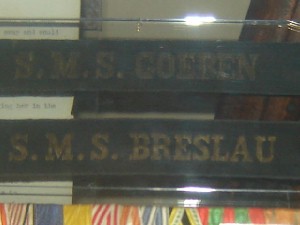
Cap Tallies from the
Goeben and Breslau
Imperial War Museum Collection
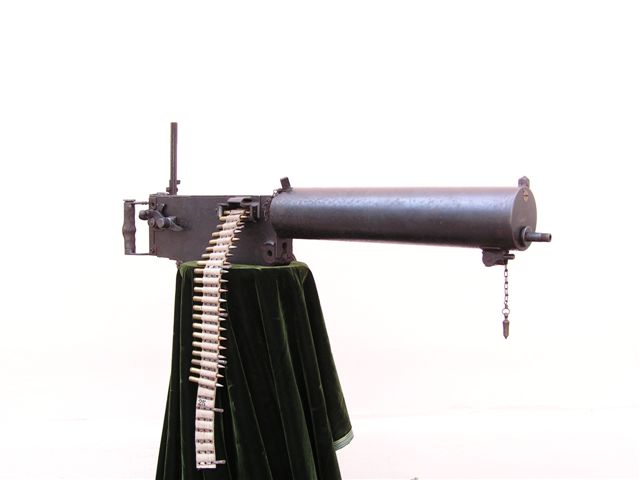
German Naval Machine Gun
Captured at Gallipoli
Photo ©
Gilles Sigro
(See Naval MG08 Page)
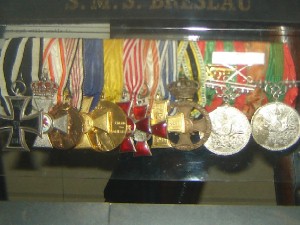
Admiral Souchon's Medal
Bar
Imperial War Museum Collection
(see Medals Page)
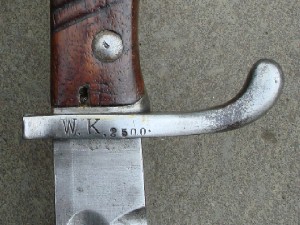
German Naval Bayonet
Captured at Gallipoli
Photo ©
Chris Wood
(See Bayonets Page)
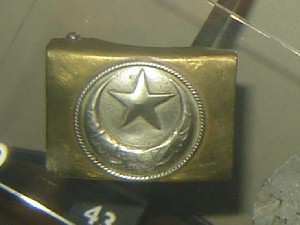
Ottoman Other Ranks Belt
Buckle
Imperial War Museum Collection
|